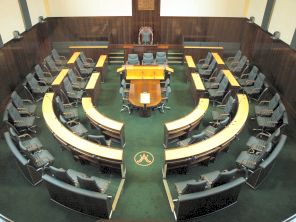House of Assembly Chamber

House of Assembly Chamber
HISTORY
From 1856 to 1940 the House of Assembly used as its Chamber the room which is now the Members' Lounge. During the late 1930s renovations and extensions were carried out which provided for a new House of Assembly Chamber as well as more office accommodation and improvements to other facilities. The Chamber was opened on 14 May 1940 by the Premier, the Honourable Robert Cosgrove MHA.
It was remodelled in the late 1970s mainly to provide for better acoustics due to the impending introduction of Hansard. The formal opening took place on 16 April 1980 and the addition of microphones at this time was to enable recording of proceedings for Hansard. After the 1998 reduction in the membership of the House of Assembly from 35 to 25, ten seats were removed.
CURRENT CHAMBER
The Chamber was last redesigned and rebuilt in 2008-09, in a style reminiscent of the original Chamber prior to the 1970s alterations, formally opening in February 2009. This new design also restored the seating capacity to 35, to enable more flexibility in the use of the Chamber , and provided new broadcasting and technology facilities.
The seating in the Chamber consists of two rows of green leather seats. The government Members sit to the right of the Speaker and the opposition Members to the left.
The Speaker’s chair is at the back centre facing the main doors. There is a public gallery above the Chamber entrance and other galleries for advisers, Hansard and the press. (The photograph above was taken from the Public Gallery facing the Speaker’s Chair.)
The Clerks are seated at a table in the centre of the Chamber: Clerk of the Assembly seated to the left, Deputy Clerk to the right and the other Clerks at the Table to the right as viewed in the photo above. The Chair of Committees (when the House is in Committee) sits between the Clerk and the Deputy Clerk.
The Bar of the House is at the entrance to the Chamber and is used if the House summonses someone before it. The Bar is normally not visible as it is concealed in a recess in the wall.
THE MACE
The presence of the Mace in the Chamber shows that the proceedings have the Speaker's and therefore the Parliament's authority.
When the House goes into Committee and the Speaker leaves the Chair or when the Speaker suspends the sitting the Mace is placed out of sight. At all other times the Mace stays in place pointing towards the government benches (on the Speaker's right).
The Mace was originally a deadly club-like weapon, often with spikes to pierce armour, used in medieval times. During the fourteenth century the Mace, by then made of precious metal and covered in jewels, had become the symbol of the King's authority. The Royal Sergeant-at-Arms could arrest people if he was carrying the Mace. Since the seventeenth century the Mace and the position of Sergeant-at-Arms have become exclusive to Parliament.
The Tasmanian Mace was donated to the Parliament in 1956 by the Davies family, and was made by Harold F. Sargison, a Hobart jeweller. The date of presentation was 4 December 1956 to mark the centenary of responsible government in Tasmania, and this was the first ever use of a Mace in Tasmania. The jewels in the Mace, which is made of sterling silver, include a blue topaz in the Maltese cross on the top. All the jewels are semi-precious Tasmanian gemstones. The engravings on it include the head of a Tasmanian tiger and blue gum leaves, the floral emblem of Tasmania. The signature of each Speaker since 1856 is engraved upon the main staff. The formal inscription upon it refers to the then owners of the Mercury newspaper and reads:
'Presented by Davies Brothers in memory of those members of the family who served in the Parliament of Tasmania'.
A major feature of the Mace is the Tasmanian Coat of Arms.
SPEAKER'S CHAIR
The Speaker's Chair is made of blackwood and was originally used in the old Legislative Council.
In 1851 the colonial Legislative Council formed a committee to plan for its new premises in the 'Long Room', now the Members' Lounge. The committee's report included an estimate dated May 1851 for furniture as follows: Lieutenant-Governor's Chair - 20 Pounds; Speaker's Chair - 15 Pounds. (Note that until 1856 the President of the Legislative Council was known as the Speaker).
When the Legislative Council moved into its current Chamber in 1856 it retained the Governor's Chair and passed the other on to the House of Assembly.
The Hobart Town Courier of 31 December 1851 describes the appearance of these chairs, saying that:
'The Chairs for His Excellency, the Lieutenant-Governor and the Speaker, are executed in blackwood (acacia melanoxylon). The design is of a most graceful and chaste description, beautifully enriched with carving, having lions' heads at the ends of the arms, and clawed feet, and upholstered with morocco leather ... '
When the freshly renovated House of Assembly Chamber was officially opened on 15 May 1940 a short debate arose as to why a newly constructed Speaker's Chair had not been used. However the Speaker, Hon. David O'Keefe was eventually complimented for having the existing chair 'remodelled and retained'.
